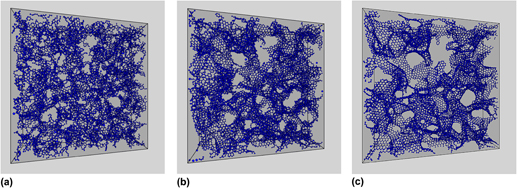Crossref Citations
This article has been cited by the following publications. This list is generated based on data provided by
Crossref.
Qiao, Shanlin
Du, Zhengkun
and
Yang, Renqiang
2014.
Design and synthesis of novel carbazole–spacer–carbazole type conjugated microporous networks for gas storage and separation.
J. Mater. Chem. A,
Vol. 2,
Issue. 6,
p.
1877.
López, María J.
Cabria, Iván
and
Alonso, Julio A.
2014.
Palladium Clusters Anchored on Graphene Vacancies and Their Effect on the Reversible Adsorption of Hydrogen.
The Journal of Physical Chemistry C,
Vol. 118,
Issue. 10,
p.
5081.
Ruz, Priyanka
Banerjee, Seemita
Pandey, M.
Sudarsan, V.
Sastry, P.U.
and
Kshirsagar, R.J.
2016.
Structural evolution of turbostratic carbon: Implications in H2 storage.
Solid State Sciences,
Vol. 62,
Issue. ,
p.
105.
Wang, Kan
Wang, Xinqiang
and
Cui, Xudong
2016.
Comparative studies of adsorption capacities for graphene based sorbents with different potential functions in molecular simulations.
International Journal of Hydrogen Energy,
Vol. 41,
Issue. 18,
p.
7419.
Suksaengrat, Pitphichaya
Amornkitbamrung, Vittaya
Srepusharawoot, Pornjuk
and
Ahuja, Rajeev
2016.
Density Functional Theory Study of Hydrogen Adsorption in a Ti‐Decorated Mg‐Based Metal–Organic Framework‐74.
ChemPhysChem,
Vol. 17,
Issue. 6,
p.
879.
Blanco-Rey, María
Juaristi, J. Iñaki
Alducin, Maite
López, María J.
and
Alonso, Julio A.
2016.
Is Spillover Relevant for Hydrogen Adsorption and Storage in Porous Carbons Doped with Palladium Nanoparticles?.
The Journal of Physical Chemistry C,
Vol. 120,
Issue. 31,
p.
17357.
Kong, Ling
Boey, Freddy
Yizhong, Huang
Xu, Jason
Kun, Zhou
Li, Sean
Que, Wenxiu
Huang, Hui
and
Zhang, Tianshu
2016.
Carbon Nanomaterials Based on Graphene Nanosheets.
p.
495.
Lomba, Enrique
Bores, Cecilia
Notario, Rafael
and
Sánchez-Gil, V
2016.
An integral equation and simulation study of hydrogen inclusions in a molecular crystal of short-capped nanotubes.
Journal of Physics: Condensed Matter,
Vol. 28,
Issue. 34,
p.
344006.
Rogacka, Justyna
Firlej, Lucyna
and
Kuchta, Bogdan
2017.
Modeling of low temperature adsorption of hydrogen in carbon nanopores.
Journal of Molecular Modeling,
Vol. 23,
Issue. 1,
Cabria, I.
López, M. J.
and
Alonso, J. A.
2017.
Searching for DFT-based methods that include dispersion interactions to calculate the physisorption of H2 on benzene and graphene.
The Journal of Chemical Physics,
Vol. 146,
Issue. 21,
de Tomas, Carla
Suarez-Martinez, Irene
Vallejos-Burgos, Fernando
López, María J.
Kaneko, Katsumi
and
Marks, Nigel A.
2017.
Structural prediction of graphitization and porosity in carbide-derived carbons.
Carbon,
Vol. 119,
Issue. ,
p.
1.
López, María J.
Blanco-Rey, María
Juaristi, J. Iñaki
Alducin, Maite
and
Alonso, Julio A.
2017.
Manipulating the Magnetic Moment of Palladium Clusters by Adsorption and Dissociation of Molecular Hydrogen.
The Journal of Physical Chemistry C,
Vol. 121,
Issue. 38,
p.
20756.
Müller, Philipp
Bon, Volodymyr
Senkovska, Irena
Getzschmann, Jürgen
Weiss, Manfred S.
and
Kaskel, Stefan
2017.
Crystal Engineering of Phenylenebis(azanetriyl))tetrabenzoate Based Metal–Organic Frameworks for Gas Storage Applications.
Crystal Growth & Design,
Vol. 17,
Issue. 6,
p.
3221.
Krasnov, Pavel O.
Shkaberina, Guzel S.
Kuzubov, Alexander A.
and
Kovaleva, Evgenia A.
2017.
Molecular hydrogen sorption capacity of D -shwarzites.
Applied Surface Science,
Vol. 416,
Issue. ,
p.
766.
Wu, Zhen
Zhu, Luying
Yang, Fusheng
Nyamsi, Serge N.
Porpatham, Ekambaram
and
Zhang, Zaoxiao
2018.
Toward the design of interstitial nonmetals co-doping for Mg-based hydrides as hydrogen storage material.
Journal of Materials Research,
Vol. 33,
Issue. 23,
p.
4080.
Martínez, José I.
Laikhtman, Alex
Moon, Hoi Ri
Zak, Alla
and
Alonso, Julio A.
2018.
Modelling of adsorption and intercalation of hydrogen on/into tungsten disulphide multilayers and multiwall nanotubes.
Physical Chemistry Chemical Physics,
Vol. 20,
Issue. 17,
p.
12061.
Alonso, Julio A.
and
López, María J.
2018.
Handbook of Materials Modeling.
p.
1.
Cabria, I.
and
El-Meligi, A.A.
2018.
DFT simulation of hydrogen storage on manganese phosphorous trisulphide (MnPS3).
International Journal of Hydrogen Energy,
Vol. 43,
Issue. 11,
p.
5903.
Alonso, Lydia
Alonso, Julio A.
and
López, María J.
2018.
Many-body Approaches at Different Scales.
p.
21.
Alducin, Maite
Juaristi, J. Iñaki
Granja-DelRío, Alejandra
López, María J.
and
Alonso, Julio A.
2019.
Dynamics of Cluster Isomerization Induced by Hydrogen Adsorption.
The Journal of Physical Chemistry C,
Vol. 123,
Issue. 24,
p.
15236.





